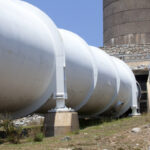
Australian airlines and Bali-bound tourists aren’t the only foreigners keeping a keen eye on the increased volcanic activity around Indonesia of late.
Since Mount Agung began erupting (see video below) at the end of November – and more recently Mount Sinabung on nearby Sumatra – The New York Times reports that NASA researchers and other scientists are on standby to study how ‘the big one’ could theoretically help curb global warming.
Gempa letusan Gunung Agung terjadi pada 13/2/2018 pukul 11:49 WITA dengan tinggi kolom asap dan abu 1500 meter di atas puncak. Status Siaga (level 3). Zona berbahaya di dalam radius 4 km dari puncak kawah. Sebanyak 15.445 orang masih mengungsi tersebar di 146 titik pengungsian. pic.twitter.com/7Ga1oRofzu
— Sutopo Purwo Nugroho (@Sutopo_PN) February 13, 2018
Powerful volcanic eruptions are one of the biggest natural influences on climate – when the Philippines’ Mount Pinatubo blew in 1991, it spewed 20 million tons of sulphur dioxide gas into the atmosphere.
The gas spread around the world and combined with water vapour to make aerosols, tiny droplets that reflected sunlight away from the Earth, lowering average global temperatures by one-degree Fahrenheit for several years.
As the world now scrambles for global warming solutions, scientists are wondering if volcanoes can help them unlock the secrets of solar geoengineering, that is, cooling the planet by making it reflect back more of the sun’s rays.
One approach would be to use high-flying jets to spray similar chemicals in the stratosphere. So, by studying the next big volcanic eruption, scientists would also gain insights into how such a scheme, known as solar radiation management, or S.R.M., might work, adds The New York Times.
“This is important if we’re ever going to do geoengineering,” said Alan Robock, a Rutgers University researcher who models the effects of eruptions and who has been involved in discussions about the rapid-response project.
“But even if there were no such thing as geoengineering, it’s still important to understand how volcanoes affect climate.”
The rapid-response effort would involve high-altitude balloon flights and other methods to gather data about an eruption as soon as possible after it begins and for several years afterward.
It would also be important to monitor the aerosols over time, to see how big they get and how they eventually break down. Bigger aerosols would fall out of the atmosphere sooner, lessening the cooling impact, say scientists.
More research needed
In a recent essay for The Wall Street Journal, Dr Gernot Wagner, co-director of Harvard University’s solar geoengineering research program, and Dr Martin Weitzman, a professor of economics at Harvard, said the effects could be substantial over time.
“Solar geoengineering is so potentially powerful, in fact, that it turns the usual economics of climate change on its head,” they write under the heading A Big-Sky plan to Cool the Planet.
But one of the biggest stumbling blocks for spraying the atmosphere with aerosols from high-flying planes is that we don’t yet know which materials would be safest and most effective, caution the doctors.
“Sulphate aerosols are featured in most plans, largely because they best match the known effects of volcanic eruptions. But they also contribute to depleting stratospheric ozone.
“Some preliminary research points to the possible use of calcium carbonate as an alternative. It has potentially better reflective properties for lowering temperatures, and it could help to restore ozone. Much more research needs to be done and may well identify other possibilities.”
They are also quick to qualify their statements in support of solar geoengineering by concluding that making the planet more reflective cannot be a replacement for cutting carbon pollution.
“At best, it is a supplement to other efforts to combat climate change, and it’s an imperfect one at that—a drug that merely moderates dangerous symptoms. The permanent solution is a regimen of diet and exercise.”


